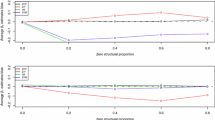Abstract.
For modeling complete female fertility we propose a zero-and-two-inflated count data model, which accounts for a relative excess of both zero and two children. As the underlying distribution of counts we use the standard Poisson distribution and the more general Gamma count distribution. We compare our proposed model with standard count data models by using data on complete fertilities for a sample of Swedish women. The preferred specification for Swedish fertility data is the zero-and-two inflated Gamma count data model. The estimated “extra” probabilities of zero and two children, when modelled as individual specific probabilities, vary substantially across individuals, with mean of 0.05 and 0.16, respectively. These extra probabilities show that women who formed a family later in life have a higher probability of being childless, and women of our youngest cohort have a higher probability of forming a two-child family.
Similar content being viewed by others
Author information
Authors and Affiliations
Additional information
Received: 7 January 1999/Accepted: 19 May 1999
Rights and permissions
About this article
Cite this article
Melkersson, M., Rooth, DO. Modeling female fertility using inflated count data models. J Popul Econ 13, 189–203 (2000). https://doi.org/10.1007/s001480050133
Issue Date:
DOI: https://doi.org/10.1007/s001480050133




